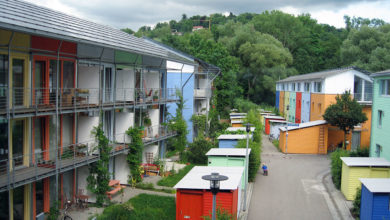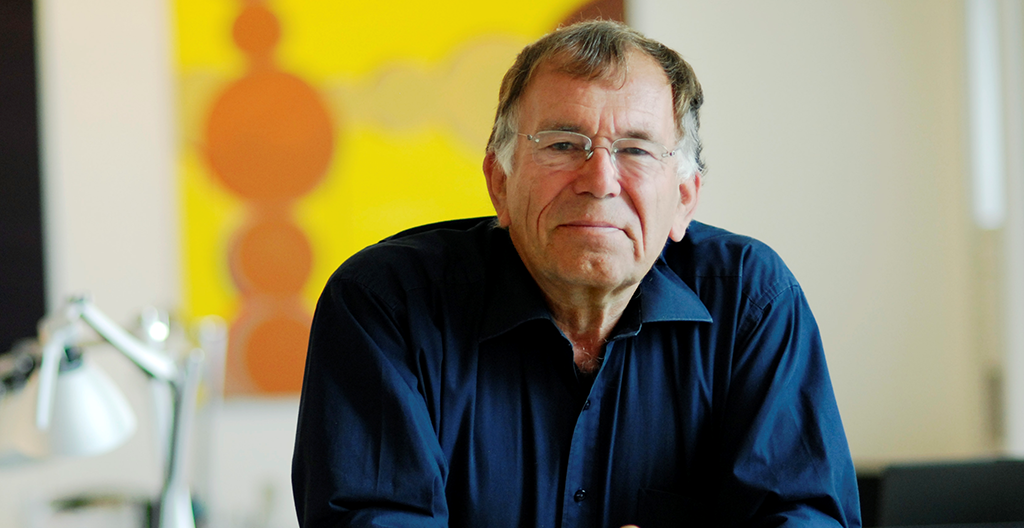
Making cities for people with Jan Gehl
The renowned Danish architect and urban designer has played a leading role in developing people-centred urbanism across the world. Foreground catches up with Jan Gehl to reflect on a lifetime involvement in shaping some of Australia’s most liveable and vibrant cities.
Alexander Maxwell-Anderson: Your upcoming talk at the Planning Institute of Australia’s conference looks to the future of liveable cities in the 21st century. Can you briefly talk through your involvement with Australian cities over your career? And how your design strategies range from addressing inherited issues from modernist planning to developing dynamic cities adaptable to future change?
Jan Gehl: I first came down to Australia in 1976 and worked in a number of universities doing studies. From 1993 I got my first commission to be a consultant to a city in Australia. And since then I have had the chance to be a consultant to every one of the big cities in Australia and New Zealand. And I would say that all of them are doing Copenhagen inspired city planning. Some of them are more successful than others, but some of them are very successful.
I’ve seen these fantastic turnarounds. I would especially mention Perth, which was really rockbottom back in the early 1990s, and has become a really nice city by now. Also, Melbourne was really rockbottom around 1990, and that has made a fantastic turn around and is now recognised as the best city in the southern hemisphere. Everybody rave’s about the miracle of Melbourne. And I would also say the miracle of Perth, and the miracle of Sydney, where Clover Moore has worked now for 16 years consistently developing a sustainability and liveability platform, to improve the city, to make it one of the best cities in Australia.
In various periods this has been in great conflict between the city government and the state government of New South Wales. But now they are increasingly coming together to work together to improve their state capital.
There have also been many small Australian cities I have worked with; Launceston and Hobart for example. Although not in Canberra. Which I’m very happy about because Canberra is a lost case from the beginning as far as I’m concerned. It’s American city planning applied to Australia. All the spaces are too big and the number of people living there, which they planned for, never came. So it’s a little underpopulated and oversized, and very complicated. But that’s another story.
AMA: Have you ever been asked to work with Canberra?
JG: No, luckily!
AMA: Would you if they asked?
JG: Yeah! Something can be done, something can be done
AMA: So you do see possibilities in retrofitting a space like Canberra?
JG: I think that’s a good example. It’s rather easy to do something with the Melbourne city center because it was not planned or made up for the motor cars. It was made with streets and parks, and then it was flooded with cars. To clean up Melbourne is to just clean up and tidy up after the car invasion, to have a good balance between the people and cars.
Canberra is sort of in between modern and old, because it is still all the elements of the old cities with boulevards and whatever. But it’s very over dimensioned, to be impressive, to be a capital. You have something similar to streets that are twice as wide. But in the new towns, after modernism, streets were changed to roads. It was a focus on the objects. All the new towns and new cities are made up of buildings, while all the old cities are made up of spaces, which is a fantastic difference from a human point of view.
It’s much easier for us, as human beings, to move around in the system of spaces for people than it is to move around between buildings made for builders and for ideologies of institutions. But there was really no concern for the landscape between the buildings.
That’s the difference between the old cities and the new cities. Working in these new cities is much more complicated than working with the old cities, which were built for people.
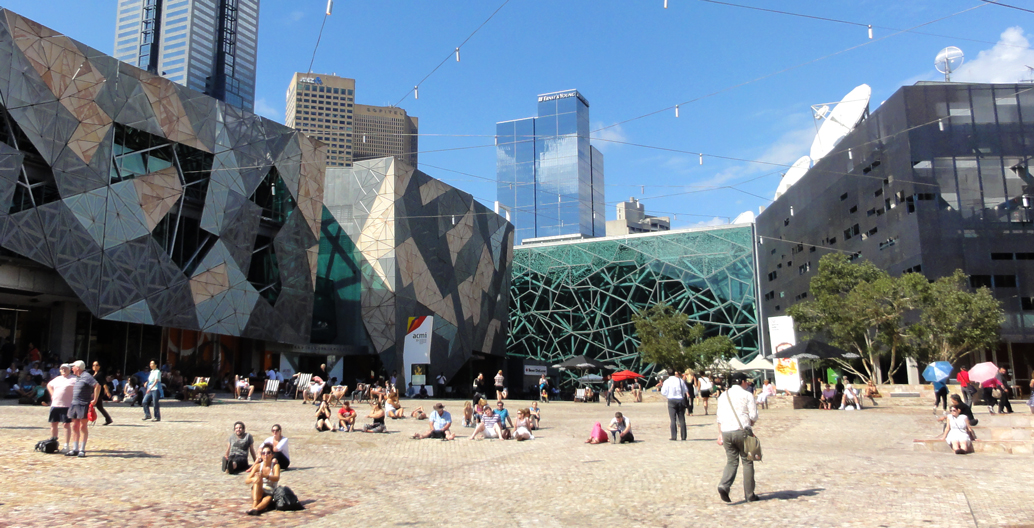
Federation Square plays host to a range of events and programs. Image: eGuide Travel
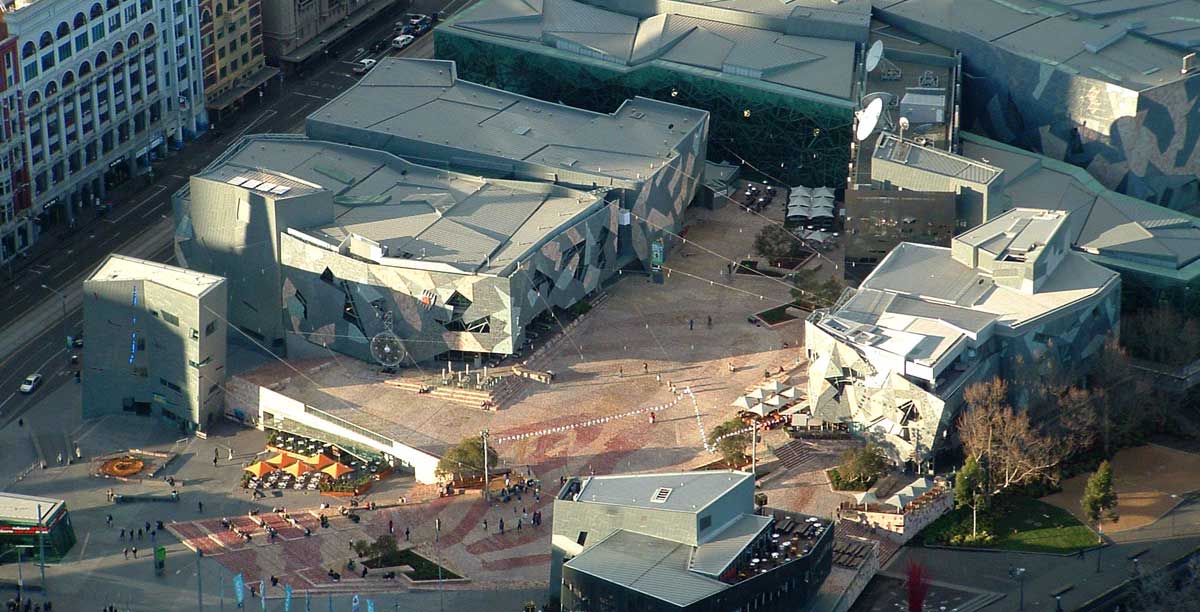
Aerial view of Federation Square.
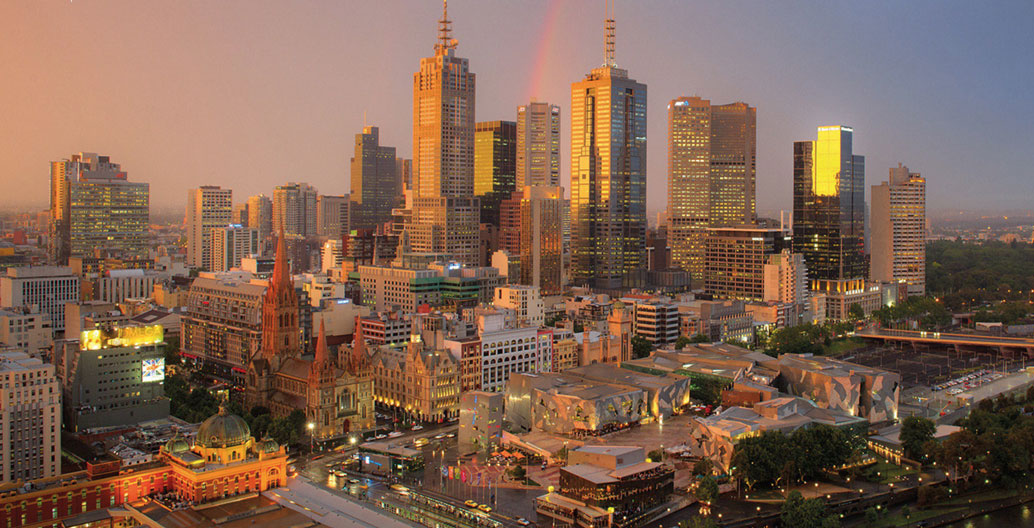
Federation Square is a much needed part of Melbourne's open space
AMA: Do you see Melbourne as still in need of those spaces in between buildings? Given that Melbourne wasn’t initially designed to have those big public spaces where people could congregate – today’s open spaces were originally fenced off to the public and quite private. And today, for example, there’s the Melbourne City Square, which over the years has obviously been whittled down to something quite small. Is there still a strong need for more space?
JG: I know that Melbourne was in a very special situation. It was a city of streets and no squares. In my talk, I refer to Adelaide as being a very lucky place because when the city was planned 200 years ago, they were given six public spaces scattered nicely in the city fabric as well as a green belt around it. How fortunate! And that was the result of far sighted city planners.
Melbourne had no squares, it was just a grid system. It became a very, very important focus when they started to revitalize Melbourne. They needed some squares and it was possible to scrape out space in front of the city hall. As you say, that square has been diminished over time, but sometimes it’s also been made much better.
In the seventies when it was conceived, it was really awful. Then it became somewhat smaller, but some of the basic things of a good square had been achieved. Then, of course, they made a completely new space for Federation Square because they had no big squares and every city needs a heart. They need some focus point. And I would say that Melbourne would really benefit by having a few more nice public spaces instead of all these streets.
Also in Sydney we are working hard to make a better square in front of Circular Quay, to make a better square around the town hall and to make a square around the railway station and link it all with a car free George Street running from one end to the other, linking the city.
A good city is made up of streets and squares. They have different functions in the life of the city. The street psychologically signals to move. We call it a movement space. So when you see this linear space, it suggests ‘go, go, go’. But when you come to a square, it signals stop the movement and start to do something else.
Throughout history, squares were always used for all other things apart from walking; the markets, the ceremonies with the church and election, the democratic expressions – everything. They needed some space for these things. So squares were always where things happened, where you stopped walking and started doing other things.
That’s why a square should not be too big or you can’t see to the other end. The famous square in Beijing is far too big. It’s not meant to be a nice square for people, it’s meant to have people feel very small in front of the state.
But Federation Square has the right dimensions, the squares in Adelaide, they’re quite good also.
AMA: These city activities and movements were dramatically reduced here in Melbourne during our lockdowns. In some ways this presented opportunity for transformative change, allowing the city council to fast track changes that prioritized people over the car; removing car parks and adding more dining space, bicycle lanes and so on.
Have you seen the impacts of COVID change the approach to designing cities for people and did planning possibilities arise that might not have been there before?
JG: We have, of course, made the general observation worldwide that the cities which had been developed so that they are quite livable and nice for people have also been the cities better accommodated to cope with the COVID situation, because there are ample parks and spaces and possibilities to walk and to bicycle. We’ve seen many cities put in extra bicycle lanes because what has really grown in this year is bicycling. Worldwide people have taken it up and the cities have provided temporary lanes and all kinds of stuff to accommodate this new moment.
But generally I’m a little bit relaxed about COVID city planning, because if we look at history, the world’s cities have been constantly met with catastrophes. There’s been earthquakes, city fires, wars, plague, cholera, tuberculosis, Spanish flu. Now we have COVID.
Generally the whole pattern of all this is that when the problem is over, we bounce back to being Homo sapiens. We forget that 100 years ago we had a much worse pandemic – the Spanish flu. Nobody can remember anything about that. And we cannot see any traces in city planning about that. So when people respond by saying leave the cities and move out to the countryside, make sidewalks nine meter wide and make elevators six by six meters to prepare for the next pandemic, I say forget it.
I would say it’s not for the architects and planners to cope with pandemics. The doctors can take care of the bacteria and the virus. We as architects and planners can do a lot about our social environment, about neighborhoods, about a good environment to grow up in as a child, a good place to be in your old days, to create spaces to meet your fellow citizens and have a friendly, relaxed situation in the streets, outside your buildings and inside your dwellings. And all of this we can do but we will have to leave the virus to the doctors.
There was in the previous century, a fantastic error being made in my point of view. That was modern planning responding to the fear of tuberculosis. It was said that maybe to beat it, we should not live in cities. We should live in separated districts, in separated houses. They changed the city of spaces to the city of buildings – to combat tuberculosis.
But after just 20 years the doctors came up with vaccines and cures for tuberculosis and for another 50 years we continued to build concrete blocks as if tuberculosis was still a major problem. By that time we had many new problems created from the way we combatted tuberculosis through building; loneliness, seclusion, alienation and crime. So I think we should be very careful to have the right discussions.
If people say that we will not have cities in human scale in the future, just to make sure that we can handle a pandemic, I think that would be completely silly. We cannot tamper with human scale – that’s related to our body. And if we blow up everything we have Canberra maybe. And who loves that?
Look at the history. Don’t be short sighted. Look a hundred years up and down.
AMA: With that being said, we’ve seen the pandemic drastically change the way that people take up public space, at least here in Melbourne. Have you seen people use space in Copenhagen in ways that you didn’t expect?
JG: I wouldn’t say not expected, but with the lockdowns, of which we have had several, we’ve seen an absolutely strong increase in people being outdoors, people walking and using the sidewalks, using the city streets, using green areas, recreation areas, parks. There’s been endless walking because people have been locked inside. They need exercise, they need fresh air. And it’s also been recommended by the health authorities that you should keep up your exercise, just try not to embrace each other.
In some of these more important recreational areas they have introduced a one way pass in the parks, so that all people move the same way – if there are too many of them.
They also used all the surplus parking wardens to make sure that people behaved and went in the right direction, because there were so many of them. People weren’t supposed to bump into each other, they were supposed to go the same direction.
A: That almost sounds like a bit of a modernist approach to using parks. Very structured.
JG: Yeah. It’s like in the traffic system, if there are too many, you have to do something, you have to make extra lanes and you have to make, maybe in a desperate situation, one way streets, one way walking.
It’s generally believed that this increase in recreation and park use are wonderful and will be a boost for the parks in future city planning. There will be more and more attention to looking after that need.
There are a couple of other changes created from this period. One is working from home. There was an existing trend for some to work from home, but now it’s been institutionalized and many, many of those who can work at home have been for a long time now.
Undoubtedly we will find out that there are some benefits from increasing numbers of people working at home. Of course, most will come back to work at least some days a week, but there will be an effect in the long run. And that, of course, could have implications for public transportation. Why do we have public transportation? Because it can take people to work and back again. So if there are fewer people going to work, then there could be added pressure to reduce public transport, which will be a catastrophe.
On the other hand, we’ve had this situation where we have smaller and smaller households and we have more and more elderly people. Elderly people especially rely on public transportation. It’s very important for them, especially if they can’t drive or have a disability. So there are some conflicting things.
The other thing I think we have seen is an increase in purchasing foodstuffs and whatever on the internet and having it delivered. That I see as a very problematic development because that means shops are closing down. Instead of pedestrians going shopping, we now have vans going on delivery. So foot traffic has been reduced and car driving has been increased. That is a very unfortunate development.
For many years, many people have used shopping as a pretext for going out. We need that pretext. So that’s an unfortunate development, I would say.
But that was already going on. And the death of shops are also going on. It has been accelerated. Which is regretful, but that is the effect.
A: It’s interesting that you mentioned loneliness and isolation before. You get the feeling here that people have really looked forward to returning to work, to the office, having that daily commute and having that proximity to people.
JG: Of course, there is a basic fact that Homo sapiens are a social animal. And by being cut off from your social relationships for a period, we are like cattle being kept in all the winter, you end up wanting to go out and graze again.
We’ve just opened the restaurants here and people are pouring in, to start up life again. And the schools have been reopened and kids are overjoyed. Much has been talk the harm of the pandemic on kids – taking online education instead of meeting their friends.
And so we really have come to realize what this society means to us, what other people mean to us, how much we long to look out of the window and see some life in the streets and along the shops and in the restaurants and going to soccer matches and festivals and whatever. It really has reinforced how important these things are in our life.
AMA: On the topic of children – there is a growing focus on a younger human-centred design in our cities. Enrique Peñalosa has said that “children are a kind of indicator species. If we can build a successful city for them, then we have a successful city for all people.”
What steps do we need to take to further build accessibility and inclusivity into our urban environments for these younger users, particularly as our cities face increasing socio-economic division and higher density urbanization?
JG: I’ll tell you two stories. One is of a Canadian organization called 880. Their idea is that if the city is good when you are eight and if the city is good when you are eighty it will be good for the rest of everyone also. So always look at one end and then the other end and see if your city works for these groups. I think that’s a very, very clever approach to city planning.
I have another story. I was in Vietnam and in the Danish embassy. There was a Vietnamese lady who was employed in the Danish embassy – she’d been to Copenhagen. And when I popped up in Vietnam, she said, ‘oh, you must have a severe baby boom in Copenhagen.’ And my wife and I, we said ‘we have no baby boom. We have a problem with reproduction. We are getting fewer and fewer Danes.’ ‘No, no, you have a baby boom’ she insisted. Then I realized what she had seen in Copenhagen was a lot of children using public spaces, that there are children on the bike lanes, there are children on the sidewalks, that children are walking to school by themselves.
In Vietnam and places like Hanoi, it was so fearful and so polluted and so much traffic that certainly young children were never taken anywhere near the urban scenery. I find that I always look for children in public space. If you see many children and many old people in the city, then it’s a sure sign it’s a city of good quality.
AMA: Looking to other users of the city, obviously a lot has changed in the city during the pandemic, a noticeable one being felt from Australia’s international border closure and the loss of international students.
Part of Melbourne’s redevelopment was this framing of the twenty four hour city – creating diversity, vibrancy and activity in the heart of the city. What importance did students have in these initial plans to revitalise the city?
JG: I think Melbourne has been very lucky because it has many of it’s universities very centrally located in the city. The international students will come back and you have RMIT and University of Melbourne very centrally located.
I’m much more worried about Perth. They have six universities and none of them are closer than five miles from the city center. That’s an awful starting point. Melbourne is much better off. Sydney is also better off with the location of the university.
We always said that university students are a very important part of a vibrant city because they have energy. They stay up at night. They can use very small cubicles to live in. They actually infuse a lot of vitality and life into the city. So to bring them out, like in Perth, in universities which are way out of town, is completely silly.
In Copenhagen, we also have reasonably close at hand the university’s and all the students’ bicycles.
When I was teaching way back in 1993 in Perth, I had 25 students. They had 31 cars between them in 1993. At this outlying university, they all arrived by car. In Copenhagen at the same time when we were doing an outing, we could hardly get enough cars on loan from the parents of students so that we could get 25 students on a study tour. The students had no cars, and in Perth, they had more than one per student. I thought that was very interesting.
But also in that regard, I’m very impressed that they’ve done so much in the Australian cities to curb excessive car driving.
I’m very proud of that. I pushed for it.
Jan Gehl will be delivering a keynote talk at the upcoming Planning Institute of Australia Conference. Tickets to the event are available for purchase here.


